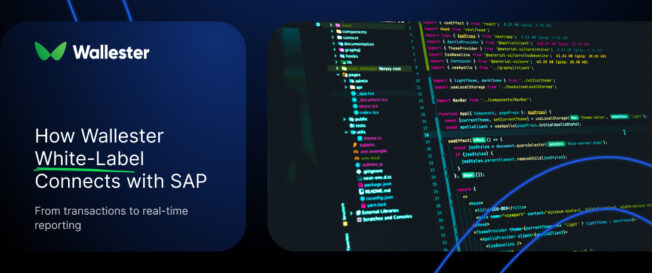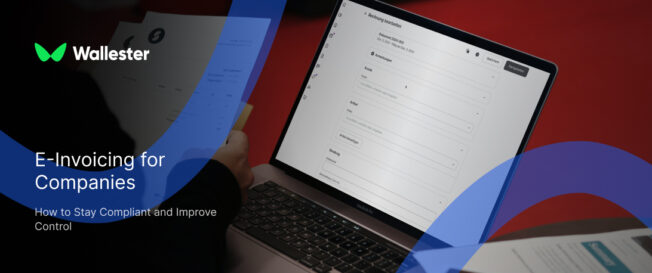Enterprise finance depends on information that moves at the same speed as money. When payments are processed through corporate cards, expense tools, and procurement systems, the data should appear in the accounting platform instantly. In many companies, however, that link still relies on manual uploads, delayed statements, or disconnected systems.
SAP remains the central system of financial management for thousands of global organisations. It handles everything from general-ledger posting to supplier management and reporting. Yet without a direct bridge between payment execution and SAP’s financial modules, the visibility required for modern finance becomes fragmented.
Wallester White-Label provides this missing bridge. By linking real-time card transactions with SAP through secure APIs, enterprises can automate how payment data is captured, categorised, and reported.
SAP and the challenge of real-time data
SAP ERP integrates accounting, procurement, and treasury into one system. Modules such as Financial Accounting (FI)and Controlling (CO) record every transaction that influences cash flow, profit centres, and cost allocations. To work effectively, these modules depend on accurate and timely data coming from outside sources – banks, payment gateways, and card-issuing systems.
Traditionally, that information reached SAP in batches. Companies imported files or reports at the end of the day, sometimes days later. For finance teams that need up-to-date reporting, this lag created practical problems:
- Cash-flow forecasts were based on incomplete data.
- Expense reports had to be adjusted manually.
- Reconciliation between card transactions and SAP entries consumed time and created errors.
To solve this, many enterprises now connect payment infrastructure directly with SAP’s finance modules. The goal is a single data pipeline that updates the ERP as each payment occurs.
Further Reading: Building a Unified Financial Architecture with Wallester API and ERP Tools
How Wallester White-Label integrates with SAP
Wallester White-Label is built around an API-first architecture, which enables enterprise clients to embed card-issuing and transaction data into any existing system, including SAP. The connection relies on secure API endpoints that exchange structured financial data between Wallester’s platform and the company’s SAP environment.
When a payment is made through a Wallester-issued card, the transaction passes through Wallester’s authorisation system in real time. Immediately after approval, the platform generates a data payload containing all relevant details – amount, merchant category code, currency, timestamp, and cardholder ID.
The transaction data is transmitted to SAP through secure, encrypted API connections authenticated by enterprise credentials. In SAP, the data is received by a middleware connector or a custom integration gateway that parses the transaction and maps it to predefined fields within the FI module. Each payment can then be associated with a vendor, cost centre, or internal project code.
In practice, the integration works across three layers:
- The API Gateway – handles the secure transfer of data from Wallester to SAP.
- The Data Mapping Layer – converts card-transaction parameters into SAP-recognised fields.
- The Validation Layer – checks that each entry meets accounting and compliance rules before posting.
After validation, the transaction can be created in SAP as a journal entry for posting under predefined rules or through approval. The process happens in seconds, creating a direct flow from payment to ledger.
Further Reading: The Complete Guide to Integrating Wallester White-Label with ERP Systems
From transaction to real-time reporting
Every transaction processed through Wallester is timestamped and traceable. When integrated with SAP, this creates a live data stream into the financial modules. Instead of waiting for reconciliation, finance teams see an updated picture of corporate spending as it happens.
Here’s what occurs during the cycle:
- A payment is initiated through a Wallester virtual or physical Visa card.
- Wallester processes and authorises the transaction.
- The transaction payload is transmitted through the API gateway to the client’s SAP connector.
- The data is matched to a vendor, department, or cost centre in SAP.
- The posting is created in the general ledger, visible immediately in the SAP reporting dashboard.
This flow eliminates batch imports and delayed updates. Reporting modules such as SAP Fiori or SAP Analytics Cloudcan display new payments instantly, allowing CFOs and controllers to review cash positions and expenses without additional input from the accounting team.
Real-time reporting transforms the way enterprises close their books. Month-end no longer requires extensive reconciliation sessions because every transaction has already been posted and verified throughout the period.

Key components of the integration
1. Secure API gateway
Wallester’s API endpoints use encrypted HTTPS connections with authenticated API requests. This setup guarantees that only verified systems exchange data. Authenticated credentials are used to manage both payment authorisation and ERP data exchange.
2. Data mapping and formatting
Card-transaction data uses fields such as merchant category code (MCC), transaction amount, currency, and timestamp. During integration, these fields are aligned with SAP equivalents in modules like FI-AP (Accounts Payable) or CO (Controlling). The mapping process defines how each type of transaction is categorised – for example, travel expenses, vendor payments, or subscription fees.
3. Error handling and sync checks
If an entry fails to post, the system flags it automatically. Error logs are visible both in Wallester’s dashboard and SAP’s interface, making it easy to correct and resubmit the transaction without duplicate postings.
4. Role-based access
Integration security extends beyond encryption. Both systems maintain permissions at user level. In Wallester, finance administrators can define which roles may initiate or view transactions. In SAP, these roles translate into corresponding access profiles, keeping the same separation of duties across both environments.
Further Reading: Automating Expense Reconciliation: Wallester White-Label and Oracle NetSuite in Action
Practical benefits for SAP users
With direct integration, the connection between payment execution and SAP reporting becomes continuous. The finance department no longer waits for confirmation or reconciliation to analyse spending.
Key outcomes include:
- Real-time synchronisation of all card-based transactions within SAP.
- Automatic categorisation of payments under the correct cost centres and vendors.
- Accurate, up-to-date data for liquidity and expense reports.
- Less administrative work for accountants and controllers.
- Stronger audit trails, with transaction IDs traceable from Wallester to SAP.
This level of automation speeds up reporting and raises confidence in data accuracy. CFOs can rely on dashboards that reflect the company’s true financial position at any moment.
Security and compliance
Any connection handling financial data must meet strict security standards. Wallester operates under PCI DSS Level 1 certification, the highest tier for card-data protection. It also processes personal and transaction data in full accordance with GDPR across the European Economic Area.
In SAP, compliance continues through established audit trails and access-control mechanisms. When both systems operate together, data remains encrypted from origin to storage. Tokenisation replaces sensitive card numbers with randomised identifiers, meaning that no raw card information ever appears in the ERP environment.
Each transaction carries a unique identifier that links back to Wallester’s secure database. During audits, finance teams can trace every payment from the initial authorisation through its accounting entry, satisfying both internal and external compliance checks.
Further Reading: From Data to Decisions: Why Finance Teams Sync Wallester White-Label with Microsoft Dynamics
Implementation overview
Integration between Wallester and SAP follows a structured process led by the client’s IT and finance teams with Wallester’s technical support.
- Connection Setup. The client registers API credentials and configures a secure connection between Wallester and SAP via HTTPS.
- Data Mapping. Finance and IT teams align Wallester transaction fields with SAP ledger accounts, cost centres, and vendors.
- Testing. A controlled data set is used to verify posting accuracy and identify mismatches.
- Validation. Once test results match expectations, the integration enters live mode.
- Monitoring. Both systems log activity and send alerts if data transmission is interrupted or delayed.
This structure allows enterprises to integrate gradually without disrupting daily operations.
Reporting and analytics
SAP’s analytics modules rely on the timeliness and quality of incoming data. With Wallester integrated, financial dashboards gain immediate access to the latest transactions. CFOs can monitor spending patterns, assess departmental budgets, and compare forecasts against real figures.
For example, a marketing team using Wallester cards for campaign spending will have every payment reflected instantly in SAP’s cost centre. This visibility helps managers adjust budgets in real time and prevent overruns before they occur. As Wallester’s data feed includes merchant category codes, finance teams can filter spending by category or department directly in SAP’s analytics tools.
Long-term impact for enterprise finance
The integration between Wallester and SAP improves the rhythm of finance operations. Real-time posting removes the divide between transaction and reporting. Every payment becomes part of a live dataset that supports better planning, quicker approvals, and accurate forecasting.
Over time, this connection leads to:
- Shorter financial close cycles.
- Fewer manual adjustments during audits.
- Stronger collaboration between finance, procurement, and operations.
- Consistent compliance across all payment and reporting layers.
The combination of SAP’s financial modules and Wallester’s API-driven infrastructure creates a workflow where decisions rely on verified data, not assumptions.
Further Reading: Why ERPs Are the Next Fintech Platforms: The Rise of Embedded Payments in B2B SaaS
Wallester’s Role in SAP Integration
Wallester’s involvement in SAP integrations focuses on more than providing an API. Enterprise clients receive structured onboarding, access to sandbox environments for testing, and monitoring tools that track data flow and system stability. This allows enterprises to connect SAP with Wallester’s infrastructure in a clear and secure way.
For companies already running SAP, the integration process fits neatly into existing financial systems. Wallester’s API layer connects smoothly with the organisation’s existing financial processes, sending transaction data into SAP in real time without affecting other modules or configurations.
Security and compliance remain consistent throughout. Wallester holds PCI DSS Level 1 certification and operates fully under GDPR, allowing enterprises to maintain the same protection standards within their SAP environment. This alignment supports corporate governance and keeps each company free to adapt the integration to its own structure and reporting needs.
From SAP transactions to clear insight
When Wallester White-Label and SAP operate together, finance teams gain a complete view of how money moves across the organisation. Transactions are authorised, categorised, and reported within a single data stream. Budgets update automatically, and reports reflect genuine activity rather than estimates.

This integration closes the gap between payments and accounting, giving decision-makers the confidence to act on current information throughout the month instead of waiting for closing periods. The outcome is a more connected, transparent, and reliable financial process.If you want to see how SAP and Wallester White-Label can work together in your organisation, visit theWallester White-Label page or contact our team for a consultation about integration options.


